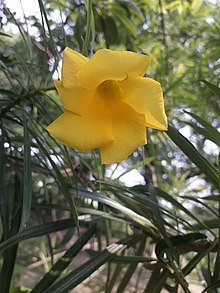Cascabela thevetia
| Cascabela thevetia | |
|---|---|

| |
| Flowers and leaves | |
| Scientific classification | |
| Kingdom: | Plantae |
| Clade: | Tracheophytes |
| Clade: | Angiosperms |
| Clade: | Eudicots |
| Clade: | Asterids |
| Order: | Gentianales |
| Family: | Apocynaceae |
| Subfamily: | Rauvolfioideae |
| Genus: | Cascabela |
| Species: | C. thevetia
|
| Binomial name | |
| Cascabela thevetia | |
| Synonyms[2] | |
| |
Cascabela thevetia (
Etymology
'Cascabel', 'cascavel' or 'cascabela' is Spanish for a small bell, a snake's rattle or a rattlesnake itself.
Description
Cascabela thevetia is an evergreen

Cascabela thevetia is commonly known as Kaneir or Kaner (कनेर) in Hindi language in
Religious importance
Its bright yellow flowers are used for religious purposes in India. The tree is native to Mexico and thus direct references to Hindu culture are new.
Toxicity

All parts of the C. thevetia plant are toxic to most vertebrates as they contain cardiac glycosides. Many cases of intentional and accidental poisoning of humans are known.[6]
The main toxins are the
A few bird species are however known to feed on them without any ill effects. These include the
In South India and in Sri Lanka swallowing the seeds of Thevetia peruviana[19] (Kaneru කණේරු (Sinhala), Manjal arali (Tamil)) is one of the preferred methods for suicides in villages where they are grown in abundance.[20]
Extracts from C. thevetia are reported to possess antispermatogenic activity in rats.[21]
In 2023, the US Centers for Disease Control and Prevention (CDC) and Food and Drug Administration (FDA) reported on weight loss supplements substituting Crataegus mexicana and Aleurites moluccanus for C. thevetia, following multiple hospitalizations.[22][23]
Uses

- Cultivation
Cascabela thevetia is cultivated as an
- Biological pest control
The plant's toxins have tested in experiments for uses in biological pest control. T. peruviana seed oil was used to make a 'paint' with antifungal, antibacterial and anti-termite properties.[24]
Gallery
-
Apricot colored flower
-
Seeds
-
Dry seeds
-
Leaves
-
White variety of Cascabela thevetia
-
Growth habit
-
Variety with apricot-colored flowers.
-
At a park in Delhi, India
-
Cascabela thevetia (Kaner) in Delhi
-
Cascabela thevetia (Karen) in Rajkot
-
Yellow Oleander
References
- . Retrieved 19 November 2021.
- ^ "The Plant List: A Working List of All Plant Species". Retrieved May 17, 2014.
- ISBN 9780849326738.
- ^ "Cascabela thevetia - Plant Finder". www.missouribotanicalgarden.org. Retrieved 2021-12-22.
- ^ a b c "Thevetia peruvians". Missouri Botanical Garden. Archived from the original on 2004-12-09. Retrieved 2011-04-19.
- PMID 8619248.
- PMID 10638101.
- PMID 22196940.
- S2CID 37334350.
- PMID 17164695.
- PMID 20438743.
- S2CID 2095538.
- ^ Kannan,R (1991). "Koels feeding on the yellow oleander". Blackbuck. 7 (2): 48.
- ^ Krishnan, M (1952). "Koels (Eudynamis scolopaceus) eating the poisonous fruit of the Yellow Oleander". J. Bombay Nat. Hist. Soc. 50 (4): 943–945.
- ^ Raj,PJ Sanjeeva (1963). "Additions to the list of birds eating the fruit of Yellow Oleander (Thevetia neriifolia )". J. Bombay Nat. Hist. Soc. 60 (2): 457–458.
- ^ Raj, P J Sanjeeva (1959). "Birds eating poisonous fruit of Yellow Oleander (Thevetia neriifolia)". J. Bombay Nat. Hist. Soc. 56 (3): 639.
- ^ Neelakantan,KK (1953). "Common Grey Hornbill (Tockus birostris) eating fruits of the Yellow Oleander (Thevetia neriifolia)". J. Bombay Nat. Hist. Soc. 51 (3): 738.
- ^ Rajasingh, Simon G; Rajasingh, Irene V (1970). "Birds and mammals eating the fruits of Yellow Oleander (Thevetia peruviana)". J. Bombay Nat. Hist. Soc. 67 (3): 572–573.
- ^ Thevetia peruviana
- ^ M. Eddleston, D.A. Warrell (1999-09-01). "Management of acute yellow oleander poisoning". QJM: An International Journal of Medicine. Retrieved 2018-02-20.
- S2CID 24757302.
- ^ Berland, Noah; Kababick, James; Santos, Cynthia; Calello, Diane P. (15 September 2023). "Notes from the Field: Online Weight Loss Supplements Labeled as Tejocote (Crataegus mexicana) Root, Substituted with Yellow Oleander (Cascabela thevetia) — United States, 2022". Morbidity and Mortality Weekly Report. 72 (37). Centers for Disease Control and Prevention: 1016–1017.
- ^ "The FDA Expands Warning to Consumers About Toxic Yellow Oleander Purported to be Nuez de la India in Certain Botanical Weight Loss Products". Food and Drug Administration. 8 September 2023. Retrieved 2 October 2023.
- ^ Kareru P.G.; Keriko J.M.; Kenji G.M.; Gachanja A.N. (2010). "Anti-termite and antimicrobial properties of paint made from Thevetia peruviana (Pers.) Schum. oil extract". African Journal of Pharmacy and Pharmacology. 4 (2): 87–89.













